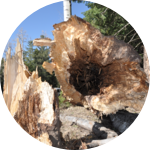About This Project
Increasing drought conditions in the southwestern USA due to climate change will result in the most widespread forest decline ever to occur in North America.
Our team of 26 scientists from the USA and Mexico study the ability of southwestern white pine to adapt to drought.
By applying drought treatments to common gardens of this species, we will learn how to improve forest survival.
We request funding to complete the installation of drought treatments at our planted gardens.
Ask the Scientists
Join The DiscussionWhat is the context of this research?
Experts agree that climate change is occurring too fast for trees to track it through haphazard seed dispersal, as trees have historically done in many cases.
By developing a better understanding of how the southwestern white pine adapts to drought stress, and discovering the most adaptable tree populations for a species, we will be able to plan for conserving this resource through assisted migration and the selection of adapted genotypes.
The persistence of southwestern white pine populations is jeopardized by climate change and due to a destructive fungal pathogen. To top it off, extirpation of this pine species would negatively influence the delicate water balance of pines subsisting in arid habitats.
What is the significance of this project?
Water is the most limiting factor for all organisms in the dry southwestern USA, and how species deal with limited water will be the primary determinant of whether they survive climate change in this region.
Our research will result in explicit population targets for gene conservation so that genetically important and threatened populations of southwestern white pine can be protected.
Most importantly, the fact that our experiment uniquely represents populations from across the entire range of this species, and incorporates numerous aspects of adaptation ensures that our data will help future researchers to develop better species distribution models and management plans to sustain varied forest types as the climate changes.
What are the goals of the project?
Our goal is to apply a drought treatment to half of our seedlings at each common garden, as shown in the video above, to better understand how pine seedlings respond to drought.
To execute this experiment, we established three common gardens in northern Arizona by the names of White Pockets, Little Mountain, and Bear Springs (https://sega.nau.edu/gardens).
Before the application of drought, we measure traits relevant to tree survival, such as seedling heights and diameters, and then re-measure these traits after each drought season. We are also assessing stable isotopes of Carbon in pine needles to understand how the seedlings adjust their water use efficiency to match different drought conditions.Budget
Each of our three gardens houses 75 raised bed boxes planted with 100 pine seedlings.
We aim to cover half of the boxes at each garden with rain-reducing shelters, following the design of Yadjian and Sala (2002), and only 2/3s of the possible number of rain-reducing shelters are currently funded and in place.
We request funds to purchase the raw materials required to build our rain-reducing shelters, including (1) 260 8' lengths of 2x4 lumber at $5.57/board = $1,448, (2) 260 shaped acrylic plastic segments (to channel rainwater away from plants) at $25 per segment = $6,500, (3) 10 boxes of 2 1/2" wood screws (133 screws per $8.38 box) = $84.
We are requesting a little over half of the total to help pay for these items.
Endorsed by
 Project Timeline
Project Timeline
Planting at the three common gardens was completed in August 2017.
Each of the three gardens now represents approximately 7,500 seedlings from across the range of southwestern white pine.
We built 2/3's of the number of required rain-reduction shelters at the gardens in July 2017, and given funding from experiment.com benefactors, we would like to have the final 1/3 of the shelters in place over our seedlings in time for the 2018 summer monsoons.
Apr 02, 2018
Project Launched
May 20, 2018
Build all rain-reducing shelters
May 25, 2018
Complete pre-drought morphology measurements
May 31, 2018
Install all rain-reducing shelters
Jul 18, 2018
Monitor pre-dawn and midday water potential through methods of Scholander et al. 1965
Meet the Team
Affiliates
Team Bio
The team of researchers working on this project have expertise ranging from forest genetics to landscape ecology and applied forest ecology. This diversity allows us to collaborate on novel research, moving science forward and finding solutions to complex issues facing trees, such as shifting climates and non-native pests. We received funding from the National Science Foundation (Grant #EF-1442597) for the basic infrastructure, and are searching for funds to add more to this large project.
Ethan Bucholz
I am a second-year PhD student in the School of Forestry at Northern Arizona University. My doctoral dissertation work focuses on adaptive characteristics of P. strobiformis and their relationship to resistance to white pine blister rust, a non-native invasive pathogen currently working its way across the southwestern US portion of the P. strobiformis range. Dr. Kristen Waring, a silviculture professor here at NAU and principal investigator on this project is my major advisor. Before attending NAU, I received a M.S. from North Carolina State University, working in the Christmas Tree Genetics department, studying biochemical resistance in different species of Abies (fir) to the non-native invasive insect Balsam Woolly Adelgid with Dr. John Frampton. I have a strong applied forest management background, working for several years with the US Forest Service in Colorado, where I became a certified timber cruiser, and working preparing timber sales in spruce beetle-killed stands. I also worked with Dr. Jim Worrall, leading a forest health crew inventorying Sudden Aspen Decline, which exhibits a strong interaction between abiotic (drought) and biotic (pathogens and insects) stress. I wish to continue my work with forest health, as climate change and invasive pests continue to pose new challenges for land managers.
Ehren Moler
I am a postdoctoral scientist with the University of Idaho Center for Forest Nursery and Seedling Research. The overarching goal of my research is to enhance the health of the world's forests through a better understanding of how past and present climate conditions influence the establishment and growth of new forests. In my current research at the University of Idaho, I use gardens containing thousands of conifer seedlings to study the effects of drought on species native to western North America. My team studies whether successive exposure of seedlings to drought is likely to enhance or reduce their resilience to strong drought. Unfortunately, climate warming is increasing the vulnerability of forests to drought, and different tree species and landscapes respond differently to water limitation, so studies are increasingly necessary to gain an understanding of how best to maintain healthy forests. In my most recently completed research, I studied responses of southwestern white pine (P. strobiformis) to excessive heat exposure during seed production, seed germination, and early seedling growth. That work revealed that warmer temperatures during seed production reduced seed germination and seedling survival. I expect that an improved understanding of the sensitivity of seeds to warming will allow for planning seed collections during periods of time when collected seeds will be most able to yield the forests of the future. Click here to learn more!
Kristen Waring
I have been researching forest ecosystems and searching for solutions to forest health problems for the past 20 years. My background includes an undergraduate degree in forestry, a MS degree in forest entomology, and a PhD from the University of California-Berkeley in silviculture and forest pathology. I have been on the faculty at Northern Arizona University since 2006, and have been working with Pinus strobiformis since 2010.
Lab Notes
Nothing posted yet.
Additional Information
Carbon isotope discrimination measures the relative abundance of the less atmospherically abundant isotope carbon-13 to the more atmospherically abundant carbon-12. Plants will differentially uptake these isotopes into their tissues, choosing the more abundant C-12 over C-13, however, when stomata close due to stress, certain plants will uptake greater amounts of C-13 leading to differentiation between individuals who take advantage of carbon resources available and those who do it less.
Isohydry and anisohydry describe plant response to stress. Generally, anisohydric individuals will maintain stomatal opening even under water stress. Juniper species represent conifers that exhibit this strategy, while pinyon pines exhibit an isohydric response, where stomatal closure follows water stress closely. Both strategies in the above examples are demonstrated in pinyon-juniper woodlands of the west, where two species take different approaches to handling water stress. Generally these tactics come with some major trade-offs relating to mortality, where isohydric species with more sensitive stomata tend to be at greater risk of carbon starvation, by significantly reducing stomatal conductance. Anisohydric species may be most vulnerable to hydraulic failure, where stomatal conductance is maintained even during very dry periods where embolism development in the xylem may lead to catastrophic failure of hydraulic conductance (McDowell et al. 2008). These mechanisms are related to water potential, and that certain species tend to operate in more narrow windows before stomatal closure, while others have wider ranges where stomata are kept open. However, the idea that water potential is the driving factor in stomatal conductance decreases is currently being challenged. Martinez-Vilalta & Garcia-Forner 2017 argue that iso/anisohydry can not be fully described by regulation of water potential due to the lack of association between water potential and stomatal conductance. This isn't to say water potential changes in leaves do not cause stomatal closure, it is more that certain species evolved hormonal signals in addition to water potential changes to control stomatal conductance. Brodribb et al. (2014) indicate that conifer species have adapted to drought through two pathways, where the anisohydric pathway relates to those species that regulate water potential and maintain stomatal opening, while isohydric species tend to hormonally regulate stomatal opening with abscisic acid. However,
Project Backers
- 16Backers
- 102%Funded
- $4,206Total Donations
- $262.88Average Donation



